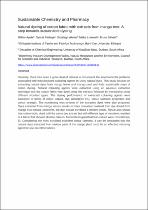 ResearchSpace
ResearchSpace
Natural dyeing of cotton fabric with extracts from mango tree: A step towards sustainable dyeing
JavaScript is disabled for your browser. Some features of this site may not work without it.
- ResearchSpace
- →
- Research Publications/Outputs
- →
- Journal Articles
- →
- View Item
| dc.contributor.author |
Ayele, M

|
|
| dc.contributor.author |
Tesfaye, T

|
|
| dc.contributor.author |
Alemu, D

|
|
| dc.contributor.author |
Limeneh, M

|
|
| dc.contributor.author |
Sithole, Bishop B

|
|
| dc.date.accessioned | 2021-04-07T09:22:22Z | |
| dc.date.available | 2021-04-07T09:22:22Z | |
| dc.date.issued | 2020-09 | |
| dc.identifier.citation | Ayele, M., Tesfaye, T., Alemu, D., Limeneh, M. & Sithole, B.B. 2020. Natural dyeing of cotton fabric with extracts from mango tree: A step towards sustainable dyeing. <i>Sustainable Chemistry and Pharmacy, 17.</i> http://hdl.handle.net/10204/11963 | en_ZA |
| dc.identifier.issn | 2352-5541 | |
| dc.identifier.uri | https://doi.org/10.1016/j.scp.2020.100293 | |
| dc.identifier.uri | https://www.sciencedirect.com/science/article/pii/S2352554120303132 | |
| dc.identifier.uri | http://hdl.handle.net/10204/11963 | |
| dc.description.abstract | Recently, there has been a great deal of interest to circumvent the environmental problems associated with manufactured colouring agents by using natural dyes. This study focuses on extracting natural dyes from mango leave and mango peel and finds sustainable ways of cotton dyeing. Natural colouring agents were extracted using an aqueous extraction technique and the cotton fabric was dyed using the extracts followed by mordanting using different mordant types. The dyeing performance of extracted colouring agents were assessed in terms of colour values, dye absorption (%), colour fastness properties and colour strength. The mordanting mechanisms of the extracted dyes were also proposed. Dyes extracted from mango leaves results in more colourised material than dye drived from mango fruit extract. Moreover, the dye extract exhibited a deeper shade. Result also shows that cotton fabric dyed with the same dye extract but with different type of mordants resulted in a fabric that showed diverse colours. Moderate to good fastness values were recorded (4–5). Considering the dyes exhibited excellent colour fastness, it can be concluded that the natural dyes extracted from various parts of the mango plant could be an effective colouring agent for use on cotton fabrics. | en_US |
| dc.format | Abstract | en_US |
| dc.language.iso | en | en_US |
| dc.source | Sustainable Chemistry and Pharmacy, 17 | en_US |
| dc.subject | Cotton | en_US |
| dc.subject | Mango | en_US |
| dc.subject | Mordants | en_US |
| dc.subject | Natural dyes | en_US |
| dc.subject | Peel | en_US |
| dc.subject | Sustainable dying | en_US |
| dc.title | Natural dyeing of cotton fabric with extracts from mango tree: A step towards sustainable dyeing | en_US |
| dc.type | Article | en_US |
| dc.description.pages | 8pp | en_US |
| dc.description.note | /© 2020 Elsevier B.V. All rights reserved. Due to copyright restrictions, the attached PDF file contains the abstract of the full-text item. For access to the full-text item, please consult the publisher's website: https://www.sciencedirect.com/science/article/pii/S2352554120303132 | en_US |
| dc.description.cluster | Chemicals | en_US |
| dc.description.impactarea | Biorefinery Industry Developme | en_US |
| dc.identifier.apacitation | Ayele, M., Tesfaye, T., Alemu, D., Limeneh, M., & Sithole, B. B. (2020). Natural dyeing of cotton fabric with extracts from mango tree: A step towards sustainable dyeing. <i>Sustainable Chemistry and Pharmacy, 17</i>, http://hdl.handle.net/10204/11963 | en_ZA |
| dc.identifier.chicagocitation | Ayele, M, T Tesfaye, D Alemu, M Limeneh, and Bishop B Sithole "Natural dyeing of cotton fabric with extracts from mango tree: A step towards sustainable dyeing." <i>Sustainable Chemistry and Pharmacy, 17</i> (2020) http://hdl.handle.net/10204/11963 | en_ZA |
| dc.identifier.vancouvercitation | Ayele M, Tesfaye T, Alemu D, Limeneh M, Sithole BB. Natural dyeing of cotton fabric with extracts from mango tree: A step towards sustainable dyeing. Sustainable Chemistry and Pharmacy, 17. 2020; http://hdl.handle.net/10204/11963. | en_ZA |
| dc.identifier.ris | TY - Article AU - Ayele, M AU - Tesfaye, T AU - Alemu, D AU - Limeneh, M AU - Sithole, Bishop B AB - Recently, there has been a great deal of interest to circumvent the environmental problems associated with manufactured colouring agents by using natural dyes. This study focuses on extracting natural dyes from mango leave and mango peel and finds sustainable ways of cotton dyeing. Natural colouring agents were extracted using an aqueous extraction technique and the cotton fabric was dyed using the extracts followed by mordanting using different mordant types. The dyeing performance of extracted colouring agents were assessed in terms of colour values, dye absorption (%), colour fastness properties and colour strength. The mordanting mechanisms of the extracted dyes were also proposed. Dyes extracted from mango leaves results in more colourised material than dye drived from mango fruit extract. Moreover, the dye extract exhibited a deeper shade. Result also shows that cotton fabric dyed with the same dye extract but with different type of mordants resulted in a fabric that showed diverse colours. Moderate to good fastness values were recorded (4–5). Considering the dyes exhibited excellent colour fastness, it can be concluded that the natural dyes extracted from various parts of the mango plant could be an effective colouring agent for use on cotton fabrics. DA - 2020-09 DB - ResearchSpace DP - CSIR J1 - Sustainable Chemistry and Pharmacy, 17 KW - Cotton KW - Mango KW - Mordants KW - Natural dyes KW - Peel KW - Sustainable dying LK - https://researchspace.csir.co.za PY - 2020 SM - 2352-5541 T1 - Natural dyeing of cotton fabric with extracts from mango tree: A step towards sustainable dyeing TI - Natural dyeing of cotton fabric with extracts from mango tree: A step towards sustainable dyeing UR - http://hdl.handle.net/10204/11963 ER - | en_ZA |
| dc.identifier.worklist | 24206 | en_US |





